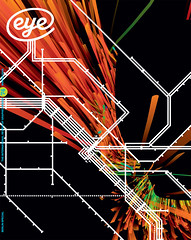Winter 2009
Repossession
After years of wrangling, the posters that the Nazis stole from Hans Sachs are to be returned to his heirs. But would they be better off in a Berlin museum?
In 1938, after a brief incarceration in the Sachsenhausen concentration camp, Berlin dentist Hans Sachs fled Germany, leaving one of the country’s richest collections of late nineteenth- and early twentieth-century poster art in the hands of the Nazis. Unlike most of the Jewish art they appropriated, however, his collection survived almost intact and, after the reunification of Germany, ended up in the Deutsches Historisches Museum (German Historical Museum) in Berlin. The museum’s catalogue, Kunst! Kommerz! Visionen! Deutche Plakate 1888-1933 (Edition Braus) lists seminal examples of poster design by, among others, Jules Chéret, Alphonse Mucha, Steinlen, Lucian Bernhard, Edmund Edel, Julius Gipkens, Max Klinger, Ludwig Hohlwein, Max Pechstein and Paul Scheurich. But, following a recent Berlin court ruling, it may have to give them all up.
In February 2009, Sachs’s son, Peter, won a test case in Berlin’s administrative court, which ordered the museum to return Thomas Theodor Heine’s ‘Red Bulldog’ poser for Simplicissimus, the German satirical magazine he edited. This judgment opens the door for a claim on the whole collection, which has been valued at €4.5 million (about £4 million), under the Washington Declaration of 1998, which set guidelines the return of artistic property stolen by the Nazis.
The case triggers an historical debate clouded by scholarship and emotion. While the posters in the museum were undeniably stolen, they have been well cared for and made available to scholars; the museum has produced a profusely illustrated full colour catalogue listing and showing Sachs’s holdings. Sachs, born in 1881, was a chemist by training and a dentist by profession, but posters were his passion. As a teenager, he collected French posters and by his twenties he was the leading private collector in Germany. In 1905 he co-founded, with Hans Meyer, the Verein der Plakatfreunde (the Society of the Friends of the Poster). Through the society’s magazine, Das Plakat (1910-21), Sachs almost single-handedly promoted German Gebrauchsgraphik (commercial art) and particularly the Berliner Plakat, a vibrant poster style – triggered by Hollerbaum & Schmidt, a Berlin printing firm and advertising agency – that wedded the fluidity of French Art Nouveau and the bold linearity of German Jugenstil into a starkly economical hybrid form.
Object posters
In 1906 a novice graphic artist named Lucian Bernhard won a poster competition sponsored by the Priester match company, with an unprecedented, reductive composition based on a couple of matches. Compared to the more ornate posters on the Berlin hoardings, the Priester image was an eye-stopper that catapulted its creator to the position of the city’s foremost poster-maker. It was the first example of a style that came to be called Sachplakat (‘object poster’), characterised by the rejection of ornament and espousal of the mundane – a typewriter, shoes, matches. Sachs befriended young Bernhard, collected all his work, and invited him to design the society’s logo and stationery.
When the magazine folded in 1921, due to internal disagreements within the society, Sachs shelved his poster collection in his attic. Some were later destroyed in a fire, but in 1926 he had a new space built to display them, and was making plans for a dedicated Gebrauchsgraphik museum.
The Nazis, however, had other ideas. Propaganda Minister Dr Joseph Goebbels had earmarked Sachs’s collection for a museum of his own devising, and in 1937 Sachs was detained and his posters confiscated.
In November 1938, Sachs was sent to Sachsenhausen but was released after a few weeks. He emigrated with his family to London, and then New York, taking only a few of his precious posters. (He sold some posters by Toulouse-Lautrec for 500 US dollars to make ends meet.) In 1961, thinking the collection had been destroyed, he accepted 38,000 US dollars in reparation from West Germany. Five years later, he learned that the East German Museum für Deutsche Geschichte had some of his posters but his requests to see them were ignored.
The collection was given to the Deutsches Historisches Museum in 1990, but it was fifteen years before Peter Sachs saw the reference on its website to ‘parts of the collection of the Jewish dentist Hans Sachs’. He immediately began the legal battle for their return. In 2007, a German restitution panel ruled for the museum, but this judgment has now been overturned. Although the later ruling did not establish Sachs’s ownership of a second item in the test case, a 1932 film poster for Die Blonde Venus starring Marlene Dietrich, it nonetheless upheld the principle that every poster once owned by his father was rightfully his.
With the question of provenance decided, the real issue is how will the posters be best cared for. Peter Sachs told the Washington Post he wanted ‘to see as much of it exposed to the general public as possible. But the Deutsches Historisches Museum has already produced important exhibitions and serious catalogues, and the history of the posters’ preservation should be considered when assessing ownership or reparations. We must hope that Hans Sachs’s collection will continue to serve scholarship, wherever it eventually resides.
First published in Eye no. 74 vol. 19 2009
Eye is the world’s most beautiful and collectable graphic design journal, published quarterly for professional designers, students and anyone interested in critical, informed writing about graphic design and visual culture. It is available from all good design bookshops and online at the Eye shop, where you can buy subscriptions and single issues.

